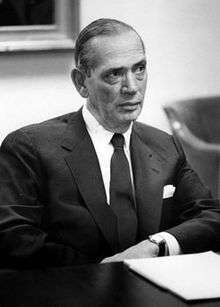Gus Levy
Gustave "Gus" Levy (May 23, 1910– November 3, 1976) was senior partner of Goldman Sachs from 1969 until his death in 1976, succeeding the renowned Sidney Weinberg.[1]
Gus Levy | |
|---|---|
 | |
| Born | Gustave Levy May 23, 1910 New Orleans, Louisiana, U.S. |
| Died | November 3, 1976 (aged 66) New York, New York, U.S. |
| Nationality | United States |
| Occupation | Investment banker |
| Employer | Goldman Sachs |
Life and career
Levy was born on May 23, 1910 in a Jewish family in New Orleans, one of three children of Sigmund and Bella Levy. Levy briefly attended Tulane University before dropping out, moving to New York City, working various jobs in the financial sector, and then joining Goldman Sachs in 1933 to head the one-man trading department for a salary of $27.50 a week. He remained at Goldman Sachs for rest of his career and rose to senior partner in 1969. Levy was known for his tremendous energy, short temper, intelligence, and generosity.
Between 1933 and 1969, Levy headed Goldman Sachs' trading department and pioneered new trading strategies such as block trading. Being from the trading department, he was not primarily banking-oriented. Upon retiring in 1969, the highly banking-oriented Sidney Weinberg had some reservations about leaving Levy in charge but ultimately decided to appoint Levy as senior partner but also introduced the eight-man "management committee" system (filled with seven older, experienced senior banking partners) to supervise Levy.
During Levy's reign as senior partner from 1969–76, Goldman Sachs experienced tremendous growth, arguably more so than during Weinberg's reign, but also encountered some major controversies, such as the Penn Central bankruptcy commercial paper scandal,[2] which tarnished the firm's reputation for several years to follow and cost the firm's partners tens of millions in litigation and legal settlements.
Levy was senior partner until he had a major stroke in October 1976 in which he fell into a coma and never recovered. He died in Mount Sinai Hospital at the age of 66. Levy never publicly declared a successor, but it was presumed that John Whitehead and John Weinberg (son of Sidney Weinberg) were to be his successors. The "two Johns" began their reign as co-senior partners in 1976.
References
- "The Goldman Sachs Group Inc".
- Hahn, Thomas K. "Commercial Paper" (PDF). In Timothy Q. Cook; Robert K. Laroche (eds.). Instruments of the Money Market (PDF) (Seventh ed.). Richmond, Virginia: Federal Reserve Bank of Richmond. Archived from the original on 2007-06-15. Retrieved 2007-01-17.
| Business positions | ||
|---|---|---|
| Preceded by Sidney Weinberg |
Chairman, Goldman Sachs 1969–1976 |
Succeeded by John C. Whitehead and John Weinberg |